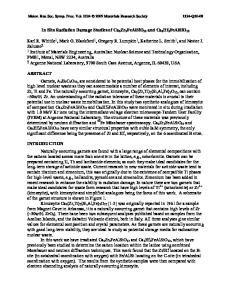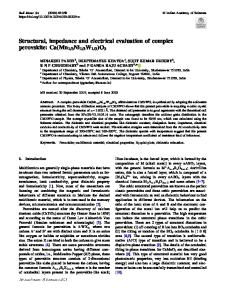Aqueous Dissolution of Perovskite (CaTiO 3 ): Effects of Surface Damage and [Ca 2+ ] in the Leachant
- PDF / 1,213,989 Bytes
- 12 Pages / 612 x 792 pts (letter) Page_size
- 53 Downloads / 309 Views
Gregory R. Lumpkin Australian Nuclear Science & Technology Organisation, Lucas Heights, NSW 2234, Australia; and Department of Earth Sciences, University of Cambridge, Cambridge CB2 3EQ, United Kingdom
Katherine L. Smith and Eric R. Vance Australian Nuclear Science & Technology Organisation, Lucas Heights, NSW 2234, Australia (Received 2 November 2004; accepted 19 May 2005)
We have characterized thermally annealed perovskite (CaTiO3) surfaces, both before and after aqueous dissolution testing, using scanning electron microscopy, cross-sectional transmission electron microscopy, x-ray photoelectron spectroscopy, and atomic force microscopy. It was shown that mechanical damage caused by polishing was essentially removed at the CaTiO3 surface by subsequent annealing; such annealed samples were used to study the intrinsic dissolution behavior of perovskite in deionized water at RT, 90 °C, and 150 °C. Our results indicate that, although mechanical damage caused higher Ca release initially, it did not affect the long-term Ca dissolution rate. However, the removal of surface damage by annealing did lead to the subsequent spatial ordering of the alteration product, which was identified as anatase (TiO2) by both x-ray and electron diffraction, on CaTiO3 surfaces after dissolution testing at 150 °C. The effect of Ca2+ in the leachant on the dissolution reaction of perovskite at 150 °C was also investigated, and the results suggest that under repository conditions, the release of Ca from perovskite is likely to be significantly slower if Ca2+ is present in ground water. I. INTRODUCTION
Perovskite (CaTiO3) is one of the principal components of the synroc family—polyphase titanate ceramics designed as host matrices for the immobilization of highlevel nuclear waste (HLW).1–3 As synroc, with incorporated HLW, is envisaged to be disposed in geological repositories, it may come into contact with ground water. Therefore, its chemical durability in an aqueous environment is an important issue. There have been many studies on the dissolution behavior of synroc4–10 and the perovskite phase alone.11–18 However, the samples used in previous dissolution tests of perovskite were in the form of as-cut (rough) surfaces, mechanically polished discs, ion-beam-thinned specimens, and powders. It is well known that cutting, polishing, ion-beam thinning, or crushing in sample preparation can lead to surface deformation and stress. For example, polished synroc discs had a damaged surface layer of ∼2 m thickness,4 and the as-cut surfaces exhibited damage to a depth of ∼50 m. 9 It was suggested that the deformation introduced by cutting led Address all correspondence to this author. e-mail: [email protected] DOI: 10.1557/JMR.2005.0294
http://journals.cambridge.org
II. EXPERIMENTAL A. Sample preparation
a)
2462
to preferential attack during room temperature (RT) dissolution tests of perovskite.13 Therefore it is highly desirable to test defect-free samples so that intrinsic dissolution behavior can be observed. In this study, we demonstrate t
Data Loading...











